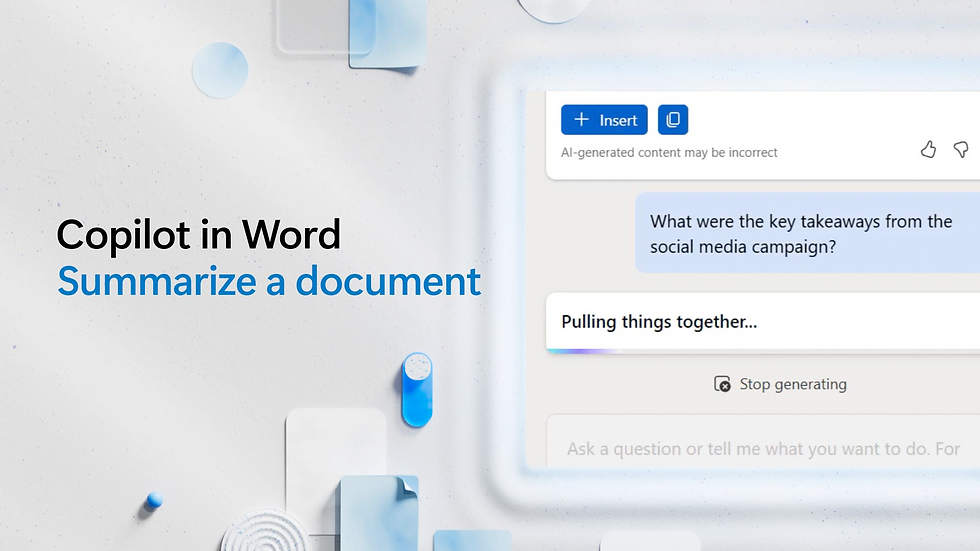Microsoft's Copilot AI Now Integrated into Samsung's 2025 TVs and Smart Monitors for Enhanced User Experience
- Olivia Johnson

- Aug 29
- 16 min read
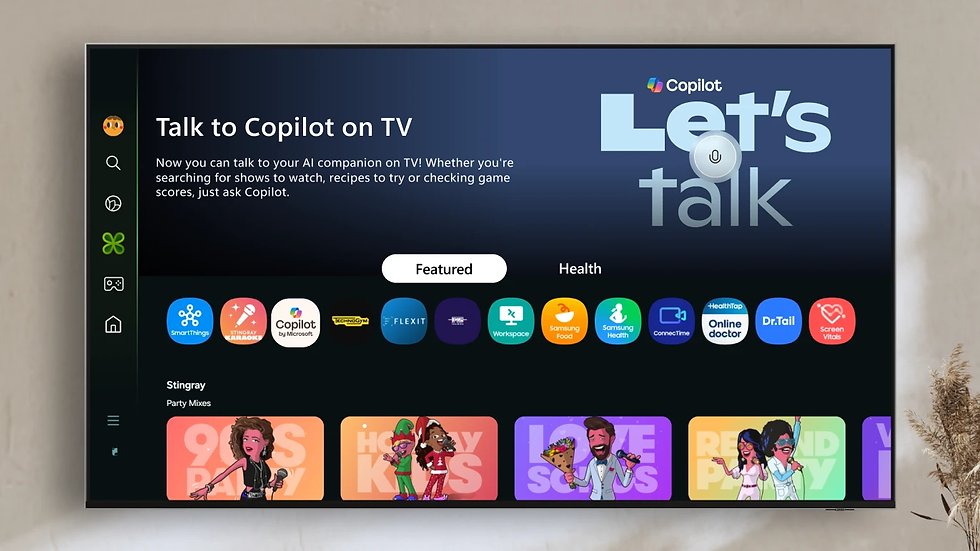
Microsoft Copilot on Samsung 2025 TVs and Smart Monitors — what this means
Microsoft announced that Copilot is coming to Samsung TVs and monitors to bring a more conversational, context-aware assistant to living rooms and home offices. In plain terms, Microsoft Copilot on Samsung 2025 TVs and Smart Monitors means the company’s generative AI assistant will be built into supported 2025 Samsung television sets and smart monitors so people can talk, search, and control apps using natural language rather than point-and-click menus or short voice commands.
This integration matters because it brings three practical benefits to everyday users and the smart home: more natural voice and conversational control for navigation and playback; personalized content discovery and recommendations tuned to household preferences; and AI-driven shortcuts that blur the lines between entertainment and productivity. For example, you could say a conversational request like “Find a light comedy similar to Last Night’s show, but with shorter episodes” and get a nuanced result, or ask your monitor to surface today’s calendar and pull a one-paragraph brief of your first meeting.
This launch is a clear example of the broader industry effort to move toward living-room AI assistants, where TVs and monitors become contextualized hubs for both leisure and work.
Industry coverage of 2025 TV product roadmaps shows Samsung and rivals packaging AI features front and center, so the timing aligns with a push for ubiquitous AI integration into consumer electronics. Over the course of this article you’ll learn what features to expect, how the Copilot architecture balances device and cloud, practical setup and optimization tips, market implications, privacy trade-offs and solutions, and answers to common questions about rollout and support. Expect hands‑on setup guidance under “Microsoft Copilot setup” and clear notes on “privacy” so you can try the features without surprises.
Key takeaway: Microsoft Copilot on Samsung 2025 TVs and Smart Monitors promises a more conversational, personalized and cross-device TV/monitor experience while raising familiar privacy and technical trade-offs.
Features and user experience improvements with Microsoft Copilot on Samsung 2025 TVs and Smart Monitors

Microsoft Copilot’s integration into Samsung hardware emphasizes conversational interaction, content personalization, and smoother cross-device continuity. At a user level, the experience is less about replacing remotes and more about augmenting them.
Conversational control and natural language
The core interaction model is multi-turn conversation: you ask a question, Copilot may ask clarifying follow‑ups, and it remembers recent context to refine results. For instance, you can say “Play the newest episode of that sci-fi show I watched last week,” and the assistant can infer the show based on viewing history instead of requiring precise titles.
Microsoft laid out conversational examples for TV navigation, search and playback that show multi-step queries and follow-ups. Those show how voice-to-command flows can move from a simple remote action to richer conversational navigation.
Accessibility benefits from conversational control because users with mobility or vision limitations can perform complex tasks without navigating deep menu trees. Conversational control simplifies complex tasks into natural language, lowering barriers for many users.
Example: Ask “Find me a quiet movie for dinner time under two hours” and Copilot can filter by runtime, genre, and viewer settings, then launch playback or queue recommendations.
Actionable takeaway: Practice a few multi-step requests (search + filter + play) to see how Copilot keeps context across turns and improves over time.
Personalized content discovery and context-aware recommendations
Copilot leverages profiles and viewing habits to surface content likely to be relevant right now—recommendations that take into account time of day, household preferences, and prior responses to suggestions.
PCWorld’s coverage of Copilot’s TV rollout highlights contextual recommendations and productivity features, and Samsung’s implementation on Smart Monitors is oriented to mix entertainment with productivity shortcuts (calendar snippets, email previews, and lightweight document editing).
Personalized content can also be toggled per profile so family members receive tailored suggestions without exposing private viewing across accounts.
Example: A Smart Monitor set up as a home office can recommend a focus playlist, mute incoming alerts, and surface a one-slide summary of a calendar item when you say “prep me for my 10 AM.”
Actionable takeaway: Create separate user profiles and link them to your Microsoft account to get precise personalization; check recommendation controls to limit cross-profile leakage.
Cross-device continuity and remote integration
Copilot promises to bridge Samsung 2025 devices and mobile clients: you can start an action on phone and continue on TV or have the TV preview your calendar and send a summary to your phone. This is part of a broader trend of treating a TV or monitor as an extension of your device ecosystem.
Cross-device continuity is most useful when accounts are linked and permissions aligned; account linking (see Technical Architecture) enables seamless handoffs.
Example: During family viewing, someone can ask Copilot to “clip the last two minutes and send it to my phone,” and the system will create a shareable clip and push it to the linked device.
Actionable takeaway: Link your mobile device and enable cross-device permissions in the Copilot settings to get seamless handoffs and remote control.
Accessibility and hands-free navigation
Copilot improves accessibility by offering voice-driven navigation, automatic summarization of video content (short captions or descriptive summaries), and enhanced caption controls. These features can reduce cognitive load for people with hearing or vision impairments.
Tools like one‑sentence summaries of long videos or spoken synopses for selected scenes can be invaluable for users who want a quick primer before watching.
Example: A viewer who is hard of hearing can ask, “Summarize the last 15 minutes of this documentary,” and Copilot will generate a short, readable summary and offer jump-to timestamps.
Actionable takeaway: Explore the accessibility section of Copilot settings to enable enhanced captions and summaries that fit your needs.
Key takeaway: Microsoft Copilot on Samsung 2025 TVs and Smart Monitors makes control more conversational and contextual, while giving users practical personalization and accessibility benefits.
Technical architecture and implementation of Microsoft Copilot on Samsung 2025 TVs and Smart Monitors

Understanding how Copilot works on Samsung hardware helps set expectations for performance, privacy and the types of features you’ll see.
System architecture overview
At a high level, the system uses a hybrid architecture: lightweight on-device components handle wake-word detection, basic intent parsing and UI rendering, while heavier generative models and contextual processing run in the cloud. On-device inference refers to executing small models locally to reduce latency and preserve privacy for basic tasks.
Sammobile’s reporting on the Samsung rollout describes firmware and OS integration points and the types of models that run locally versus in the cloud. Microsoft’s announcement provides examples of the cloud‑assisted services used for richer understanding and content generation.
Runtime requirements include a current firmware version, a stable internet connection for cloud calls, and a linked Microsoft account for personalization and cross-device features.
Example architecture: A voice query is first captured and processed on-device to remove background noise and detect intent; non-sensitive commands like “volume up” may be executed locally, while complex multi-turn searches are forwarded to cloud Copilot services that return ranked, context-rich results.
Hybrid design balances responsiveness and capability by keeping trivial tasks local and sending heavy lifting to cloud models.
Latency, performance and model orchestration
To keep interactions feeling instant, systems use caching and model orchestration. Frequently asked queries and common recommendations are cached locally. When cloud inference is required, systems prioritize short contextual payloads and prefetch content metadata to reduce perceived delay.
Low-latency is achieved through a mix of local pre-processing, predictive caching, and regional edge servers handling model inference close to users.
Example scenario: If you ask “Resume last show,” the device can often serve the correct stream state from local cache because of recent playback metadata, avoiding a full cloud round-trip.
Actionable takeaway: Keep firmware and apps updated and use a reliable broadband connection to benefit from low-latency behavior.
Security, authentication and account linking
Personalized Copilot features require account linking and trusted authentication between Microsoft and Samsung services. Typically this uses OAuth flows where you log into a Microsoft account and grant permissions to the Samsung device.
Sammobile’s coverage outlines how account linking and device authentication will be handled in the onboarding flow. Microsoft’s documentation clarifies that linked accounts enable calendar previews, email snippets and cross-device continuity features that depend on permissions.
Security measures include device tokens, refreshable credentials, and scoped permissions so that specific data types (calendar, email, viewing history) require explicit consent.
Example: When you set up Copilot on a Smart Monitor, the onboarding will ask you to sign into your Microsoft account and show a permissions screen listing what the monitor can access (calendar, files, profile). You can reject or granularly allow access.
Actionable takeaway: Review the permission screen during Microsoft account linking and only grant access needed for your intended features.
Implementation specifics and rollout details
Copilot availability will depend on firmware updates and model support. Sammobile lists supported 2025 Samsung TV and Smart Monitor models and describes the firmware update process and onboarding flow for consumers.
Rollout is typically phased: early markets and flagship models first, followed by broader availability as firmware and services stabilize. The onboarding flow often includes voice training and an explanation of privacy choices.
Samsung’s Tizen-based TV software will host the Copilot client, integrating with existing app ecosystems and remote controls.
Example rollout: Initial support may appear on selected 2025 Samsung TVs in North America and Europe, arriving via an over-the-air firmware update that adds a “Copilot” tile to the home screen and walks users through linking accounts.
Actionable takeaway: Check your model’s support page and enable automatic firmware updates to receive Copilot as soon as it’s available.
Key takeaway: Copilot integration on Samsung Smart Monitors uses a hybrid architecture that balances on-device responsiveness with cloud capabilities, requiring account linking and firmware updates for full functionality.
Setup, optimization and community tips for Microsoft Copilot on Samsung Smart Monitors and TVs
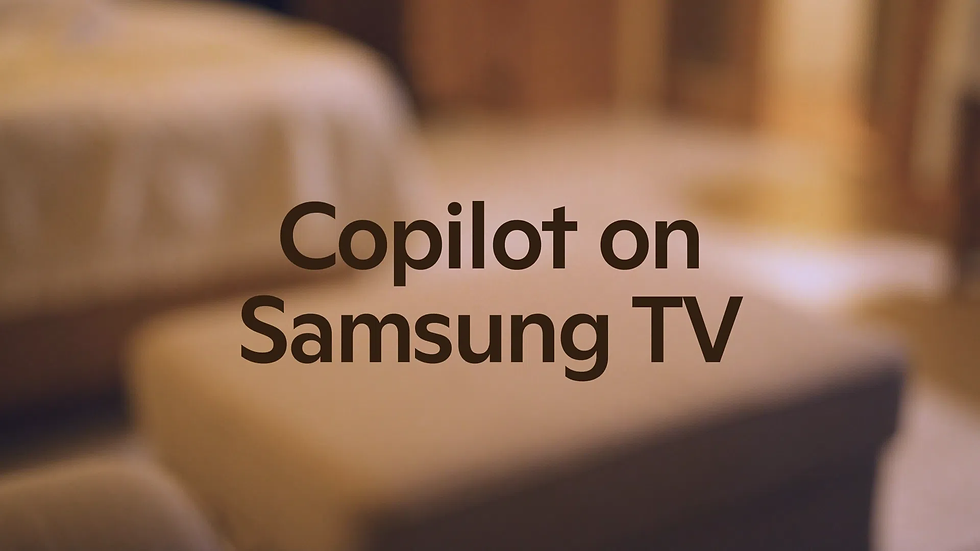
Getting Copilot up and running is straightforward, but a few configuration steps will make your experience smoother and protect your privacy.
Step‑by‑step setup walkthrough 1. Ensure your 2025 Samsung TV or Smart Monitor is updated to the latest firmware and connected to reliable Wi‑Fi. 2. Launch the Copilot tile from the home screen or follow the automatic onboarding prompt after an update. 3. Link your Microsoft account during setup to enable personalization and cross-device features. Approve the scoped permissions you are comfortable with. 4. Complete any voice training prompts to improve recognition accuracy and configure preferred voices and language. 5. Explore the initial settings: recommendation controls, accessibility features, caption preferences, and cross-device linking.
A little time in setup pays off in fewer misfires later.
Example: During the account link you may be prompted to scan a QR code with your phone, which speeds signing in and securely establishes device trust.
Actionable takeaway: Perform voice training during setup and create individualized profiles so recommendations and privacy settings are applied correctly.
Optimization tips and customization
To optimize Copilot: adjust recommendation sensitivity, enable or disable cross-device features, and tune performance settings (e.g., prefer local responsiveness vs. richer cloud answers).
If you want to prioritize privacy over personalization, limit stored viewing history and turn off long-term personalization while keeping voice activation enabled for convenience.
For Smart Monitors used as work devices, enable “focus” settings so Copilot suppresses entertainment recommendations during work hours and surfaces productivity shortcuts instead.
Example: Turn on a setting that mutes recommendations until after 6 PM, which keeps your home office monitor data usage and suggested content relevant to work hours.
Actionable takeaway: Use the Copilot settings to balance personalization and privacy; create a household rule (work hours vs. leisure hours) to reduce irrelevant suggestions.
Community-sourced troubleshooting and how‑to’s
Early adopters have already documented common fixes: reboot after the firmware update, re-link Microsoft account when the on‑device token expires, and verify that the TV’s language and voice settings match the Microsoft account locale.
Common community tips include clearing app cache if Copilot tiles don’t appear, checking router QoS settings when audio is choppy, and using an Ethernet connection for critical low-latency tasks.
Example: If Copilot fails to identify a user profile, remove the account link and re-link using the TV’s settings > Copilot > Accounts menu.
Actionable takeaway: Visit community threads for device‑specific fixes, but always confirm steps against official Samsung and Microsoft support instructions before changing system settings.
When to contact support
Contact Samsung support if a firmware update fails or the Copilot tile is missing post-update; escalate to Microsoft if the problem is clearly tied to account authentication or cloud responses.
Known version mismatches (e.g., older TV firmware incompatible with the latest Copilot service) often require an update or temporary rollback instructions from Samsung.
Example: If your Smart Monitor is on the expected model list but the Copilot feature never appears after weeks, open a support ticket with Samsung and include logs if possible.
Actionable takeaway: Keep a note of firmware version, Copilot client version (if shown), and the Microsoft account email when contacting support; this speeds resolution.
Key takeaway: A successful setup is a mix of firmware readiness, careful permission choices, and occasional community troubleshooting—start with voice training and per-profile privacy settings.
Market impact and industry trends around Microsoft Copilot integration in Samsung 2025 TVs and Smart Monitors

Microsoft and Samsung’s collaboration signals strategic positioning that could shape both device ecosystems and the broader AI-in-consumer-electronics market.
Strategic partnership significance
The partnership shows platform companies and OEMs view living-room devices as strategic surfaces for AI assistants rather than mere content displays. By embedding Copilot, Samsung adds a high-profile AI partner to its 2025 lineup, and Microsoft extends Copilot’s reach into consumer hardware.
TechRadar’s analysis of 2025 TV plans highlights how both LG and Samsung are aggressively adding AI features to their devices, indicating a new phase of platform partnerships.
For Microsoft, Copilot in TVs expands the assistant footprint beyond PCs and phones, influencing how users discover content and interact with services.
Strategic OEM-platform partnerships will likely accelerate the embedding of AI copilots across device categories.
Example: If Samsung’s Copilot adoption is strong, smaller OEMs may seek similar deals with cloud AI providers or build proprietary assistants, shifting the competitive landscape.
Actionable takeaway for industry observers: Watch device activation metrics and early usage patterns to gauge whether TV-based AI becomes a primary or secondary interaction surface.
Competitive landscape and comparisons
Samsung’s 2025 approach emphasizes a cross-over of entertainment and productivity, while other manufacturers such as LG are also promoting AI-driven experiences with a different assistant strategy. PCWorld notes that Copilot’s TV move starts with Samsung and LG is likely to follow with its own integrations.
Samsung’s advantage lies in scale and an existing app ecosystem on Tizen, but competitors may differentiate with unique local models, proprietary content partnerships, or stronger privacy controls.
Example: LG could emphasize on-device AI and local privacy controls, while Samsung + Microsoft may lean on cloud-backed generative features and cross-device continuity.
Actionable takeaway for buyers: Compare feature trade-offs—cloud-powered generative replies vs. stronger local privacy—when selecting a 2025 TV or Smart Monitor.
Consumer adoption forecasts and business implications
TV-based AI will change discovery, advertising and bundling models: personalized recommendations can increase engagement but also create new targeting opportunities for advertisers and content platforms.
As Copilot surfaces rich previews and creates clips, it could shorten the path from discovery to consumption, increasing click-through for subscribed services and potentially reshaping subscription architectures.
Consumer adoption will depend on perceived utility and trust: if early users find Copilot improves discovery and everyday tasks without intrusive data collection, adoption should accelerate.
Example: A streaming service could partner with Copilot to offer personalized trial episodes that are surfaced through conversational queries, boosting conversions.
Actionable takeaway for businesses: Evaluate partnerships that leverage Copilot’s contextual signals (with user consent) to improve content discovery and conversion metrics.
Research-backed perspective
Academic and industry research on AI assistants suggests that contextualized, multi-turn assistants improve task completion rates and user satisfaction when privacy controls and transparency are present. See research exploring AI assistants in consumer settings for parallels with retail and enterprise copilots. Recent preprints analyze how assistant feedback loops and telemetry inform product improvement and ROI expectations.
These studies indicate that incremental UX improvements—better follow-up handling, clearer permission dialogs, and measurable latency reductions—translate into stronger adoption in the short term.
Actionable takeaway for researchers and product teams: Instrument early deployments with clear metrics (engagement, task completion, opt-out rates) to validate ROI and inform iterative design.
Key takeaway: The Microsoft–Samsung Copilot tie-up is likely to accelerate platform-level AI adoption, change content discovery economics, and force competitors to refine their AI strategies.
Challenges, privacy considerations and solutions for Microsoft Copilot on Samsung Smart Monitors and TVs
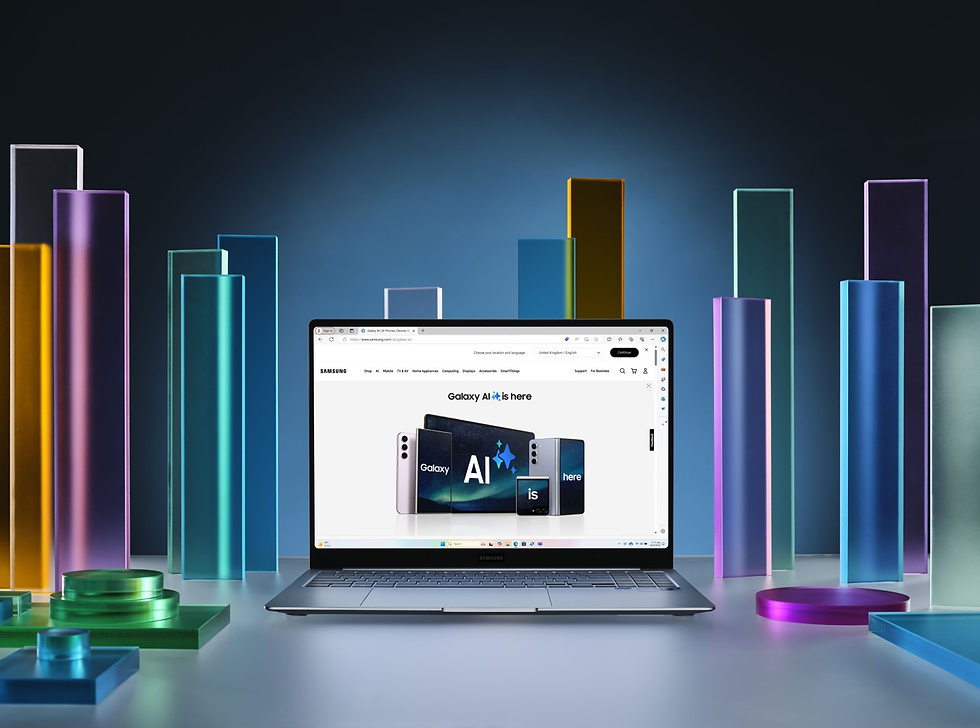
The benefits of Copilot come with trade-offs. Recognizing these challenges and practical mitigations helps users and organizations steer toward safer, more usable deployments.
Privacy and data handling concerns
Voice capture, personalization storage and potential third-party data sharing are core privacy concerns. Users need clear controls over what is stored and for how long—particularly sensitive data like calendar items and message snippets.
TechRadar’s coverage raises privacy conversation points as part of the 2025 TV AI wave, while Microsoft’s product notes describe permission-based linking for data access.
Companies typically address these issues through scoped consent, on-device retention options, and transparent logs that let users review and delete stored voice interactions.
Example: A family might choose to disallow long-term storage of voice queries while permitting short-term context during an active session.
Actionable takeaway: Review and apply the privacy toggles during setup—disable long-term personalization if you prefer minimal data retention.
Technical obstacles and mitigations
Firmware compatibility, model updates and network dependency create technical friction. Devices on older firmware may not receive new Copilot features or may experience degraded performance.
One mitigation is offering graceful offline fallbacks for core functionality (volume control, app launching) and explicit error messages when cloud features are unavailable.
Telemetry—the product‑level usage data—helps engineers prioritize stability fixes and reduce false activations, but it must be balanced with privacy.
Example: If the network drops, Copilot should still support local playback commands and offer a clear explanation that advanced generative features are offline.
Actionable takeaway: Keep devices updated and enable automatic updates; consider wired connections in congested Wi‑Fi environments.
UX friction points and accessibility tradeoffs
Misrecognition, false activations and excessive suggestions are common UX friction points. Iterative research and telemetry can reduce these, but early deployments often experience higher error rates.
Users with accessibility needs may require more precise captioning and predictable behavior; Copilot iterations should prioritize stability over novelty for these groups.
Example: False activations can be reduced by adjustable wake-word sensitivity and contextual suppression (e.g., only respond to the main remote’s microphone).
Actionable takeaway: Use sensitivity settings and test Copilot with household noise levels to find a balance between responsiveness and false positives.
Practical solutions and recommendations
Companies should offer clear privacy controls, transparent logs for voice interactions, and firmware best practices that minimize downtime. Community documentation and official support channels should collaborate to surface common fixes.
For users: audit permissions after the initial setup, keep user profiles separated, and use network-level controls for devices you don’t fully trust.
Example: Enabling a daily or weekly reminder to review Copilot permissions can catch unintended data sharing early.
Actionable takeaway: Combine official privacy settings with simple household rules (separate profiles, scheduled do-not-disturb) to get the best of Copilot without sacrificing control.
Key takeaway: Thoughtful privacy controls, robust firmware management and incremental UX iterations can resolve most friction points while preserving Copilot’s benefits.
Frequently asked questions about Microsoft Copilot on Samsung 2025 TVs and Smart Monitors
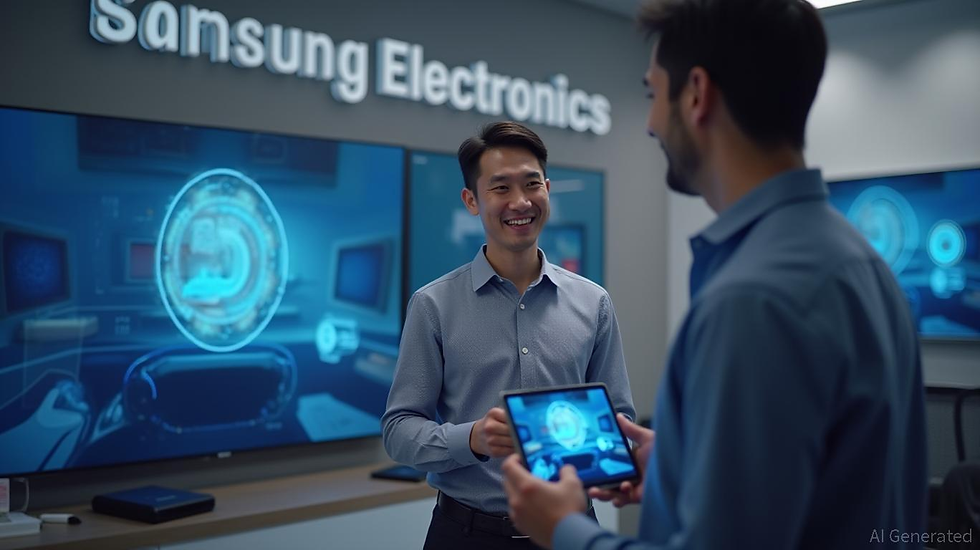
Q1: Which Samsung 2025 TVs and Smart Monitors will support Microsoft Copilot and when will it roll out?
Short answer: Support starts with select 2025 Samsung TV and monitor models and rolls out via firmware updates in phases. Sammobile lists supported models and describes the firmware rollout process for these devices. Check your Samsung support page or the Copilot tile on your device for the latest availability.
Q2: How is my voice data used and can I opt out of personalization?
Short answer: Voice data is used to process requests and improve personalization if you grant permission; you can opt out of long‑term personalization and clear stored voice training data in the Copilot settings. Microsoft’s product notes explain the permission model and how account linking enables features that use voice and activity context at runtime. Microsoft’s Copilot announcement outlines how permissions and linked accounts enable personalized features.
Q3: Does Copilot work offline or without a Microsoft account?
Short answer: Basic commands (volume, input switching) often work without cloud access, but most generative and contextual features require a Microsoft account and cloud connectivity. For richer content recommendations and cross-device continuity you need to link your Microsoft account. Sammobile’s coverage of implementation specifics emphasizes the need for account linking and cloud services for full functionality.
Q4: How do I troubleshoot common setup issues on Samsung TVs and monitors?
Short answer: Verify firmware is up to date, confirm Wi‑Fi connectivity, re-link your Microsoft account if authentication fails, and consult community threads for model-specific fixes. Community setup guides on Reddit collect practical troubleshooting steps that many users find helpful.
Q5: Will Copilot replace existing voice assistants or work alongside them?
Short answer: Copilot is designed to coexist with other assistants; device defaults and settings let you choose which assistant handles certain interactions. Switching preferences is possible in system settings, and both assistants can serve different roles (e.g., one for home automation, Copilot for generative content).
Q6: Is there research that supports the user benefits claimed for Copilot-style TV assistants?
Short answer: Yes, academic studies and recent preprints on AI assistants in consumer devices and retail contexts show improved task completion and user satisfaction when assistants are contextualized and privacy-aware. See papers analyzing AI assistant impact and telemetry-informed improvements for device deployment insights. Recent research explores AI assistant impacts in consumer contexts and product improvement cycles.
Q7: When should I contact Samsung versus Microsoft support?
Short answer: Contact Samsung if the issue is firmware-related, device behavior, or missing Copilot features post-update. Contact Microsoft for account authentication problems or cloud-based service failures. Include firmware version, account email, and exact error messages when filing tickets.
Conclusion: Trends & Opportunities — executive summary and next steps

Microsoft Copilot on Samsung 2025 TVs and Smart Monitors marks a meaningful step in making living-room and home-office screens more conversational, personalized and productive. The partnership combines Samsung’s hardware footprint and Tizen platform with Microsoft’s cloud-powered Copilot capabilities to offer richer content discovery, enhanced accessibility and cross-device continuity.
Near-term trends to watch (12–24 months) 1. Proliferation of conversational, multi-turn assistants across major TV and monitor lines. 2. Hybrid edge/cloud deployments that emphasize low-latency responses for common tasks while routing complex queries to cloud models. 3. Increased emphasis on privacy controls and per-profile personalization to win consumer trust. 4. New content-discovery and ad models that leverage contextual AI signals (with consent). 5. Rapid iteration driven by telemetry and community feedback to reduce false activations and improve UX.
Opportunities and first steps 1. For consumers: follow the setup checklist—update firmware, link accounts with intentional permissions, complete voice training and create per-user profiles. Start by testing a few multi-turn queries to learn how Copilot adapts. 2. For developers and partners: explore partner programs and APIs exposed by Microsoft and Samsung for contextual content recommendations, clipped content workflows, and cross-device actions—prototype integrations that respect user consent and privacy by design. 3. For researchers and product teams: instrument early deployments with clear metrics (engagement, task completion, opt-out rates) and publish learnings to accelerate best practices for TV-centric AI assistants. 4. For industry observers: monitor adoption metrics and compare feature trade-offs across OEMs (cloud richness vs. on-device privacy) to predict consumer migration patterns.
Trade-offs and uncertainties
The balance between cloud capability and local privacy will be contested; different OEMs may choose different points on this spectrum. Hardware diversity and global regulatory environments also create rollout variability. Finally, user trust will hinge on transparent privacy controls and consistent, low-friction experiences.
Final takeaway: Microsoft Copilot on Samsung 2025 TVs and Smart Monitors opens a new chapter for AI in the home—one that blends entertainment, accessibility and productivity—provided vendors, developers and users prioritize clear privacy choices, robust firmware management and iterative UX improvements informed by real-world telemetry and community feedback.


